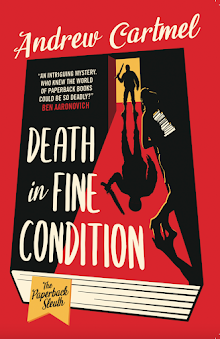And indeed, Tremor of Intent at first is highly entertaining, very promising and rather splendid. Complete with a colourful antagonist and "blonde pouting girls who twitch for savage anonymous love" — there is also a girl with "hair you wanted to eat" — it looks like it might be very much in the vintage Bond mould.
 It is particularly Fleming-like in Part II, where it shifts from the first person narrative to third person and Burgess begins referencing brand names like Daks (a make of menswear). But with his baroque language and sardonic humour Burgess soon begins to seem more like Derek Marlowe, another great British spy novelist.
It is particularly Fleming-like in Part II, where it shifts from the first person narrative to third person and Burgess begins referencing brand names like Daks (a make of menswear). But with his baroque language and sardonic humour Burgess soon begins to seem more like Derek Marlowe, another great British spy novelist.Then the narrative grows more satirical — and acquires a slightly surreal edge — with a gourmet eating contest between the British intelligence operative hero Hillier and his hugely fat antagonist (a literal heavy). It appears to be moving towards the more way-out fiction of Kyril Bonfiglioli. Unfortunately, by the time the book is over Burgess has drifted in the direction of Graham Greene at his worst — self important, dull and priest-ridden. So much for the prospect of a classic 1960s spy novel.
 Part of the problem is that, like so many respectable 'literary' writers (but unlike Kingsley Amis, or Graham Greene when he is on form), Burgess doesn't understand or respect the principles of genre fiction. This is clearest in the way that Hillier never confronts the real villains of the novel — shadowy senior intelligence figures and politicians. Indeed these villains remain pretty much offstage. Instead Hillier arbitrarily and pointlessly goes after a strictly minor bad guy, for no better reason that he has featured heavily in the plot (he is on stage) and bumps the bad guy off in a dull fashion. This is what happens when you bungle your structure, Anthony.
Part of the problem is that, like so many respectable 'literary' writers (but unlike Kingsley Amis, or Graham Greene when he is on form), Burgess doesn't understand or respect the principles of genre fiction. This is clearest in the way that Hillier never confronts the real villains of the novel — shadowy senior intelligence figures and politicians. Indeed these villains remain pretty much offstage. Instead Hillier arbitrarily and pointlessly goes after a strictly minor bad guy, for no better reason that he has featured heavily in the plot (he is on stage) and bumps the bad guy off in a dull fashion. This is what happens when you bungle your structure, Anthony. Worse yet, there is a coda where the hero discovers god. I'm not kidding. That's what I meant by that crack about Graham Greene.
Worse yet, there is a coda where the hero discovers god. I'm not kidding. That's what I meant by that crack about Graham Greene.Still, Burgess can certainly write. We have a scientist character who is "a highly efficient artefact crammed with non-human knowledge." The Cold War is "a great childish game on the floor of the world." And as Hillier entered a sinister foreign sea port, "A dog barked somewhere in comforting international language."
Also, this being Burgess, there are vivid musical references (when a character thinks about the woman he loves, "he looked for a moment as though he were listening to Beethoven"). And of course, the glittering, show-off vocabulary. Among the ten dollar words are old favourites like proleptic, ludic, mimesis and otiose. New friends include phatic, aleatoric, pudeur and 'gulous' — a word that seems to pertain to gluttony, but is nigh impossible to track down online. Often Burgess's highfaluting language strikes me as both otiose and aleatoric. He should feel pudeur.

More interesting are his own invented words. Hillier is trapped by the opposition and dosed with a (fictional) compound called 'vellocet' — a drug which also crops up in Clockwork Orange. Here it is B-type vellocet, which induces euphoria and loosens the tongue. In Clockwork Orange it is Moloko Vellocet, which is mixed with milk and will "sharpen you up and make you ready for a bit of the old ultra-violence."
Tremor of Intent is a disappointment, but one with extended moments of brilliance. (Oh, and the title refers to a trembling of the muscles you get when attempting a precise movement. Like aiming a gun, or a bow and arrow.)

(Image credits: Thin pickings from Good Reads, though they did at least yield the stylish graphic Serpents Tail edition with the typewriter. The sniper rifle Ballantine, which is the edition I read, is from ABE seller 1. The nice photographic Penguin is from ABE seller 2. The silenced gun photograph Heinemann first is from ABE seller 3. The lovely cartoony Norton paperback is from ABE seller 4. The equally attractive stripey eyes Norton first edition is from ABE seller 5. Regarding the Nortons — "eschatological" means the branch of theology concerned with death, judgement, heaven and hell (bless you, Oxford English Dictionary!) — which gives you some idea of the god-bothering pretentiousness which finally and fatally sinks this book.)





Hmm, sounds like a scattergun and somewhat tongue in cheek approach to the spy genre and its greatest proponents that doesn't really come off. Thanks for the review, I'd never heard of it before.
ReplyDeleteHey Mark, I'd been meaning to read this novel for years, since I'm an admirer of Burgess and a fan of spy novels... I'm just sorry it wasn't a better book. Thanks for reading!
ReplyDelete